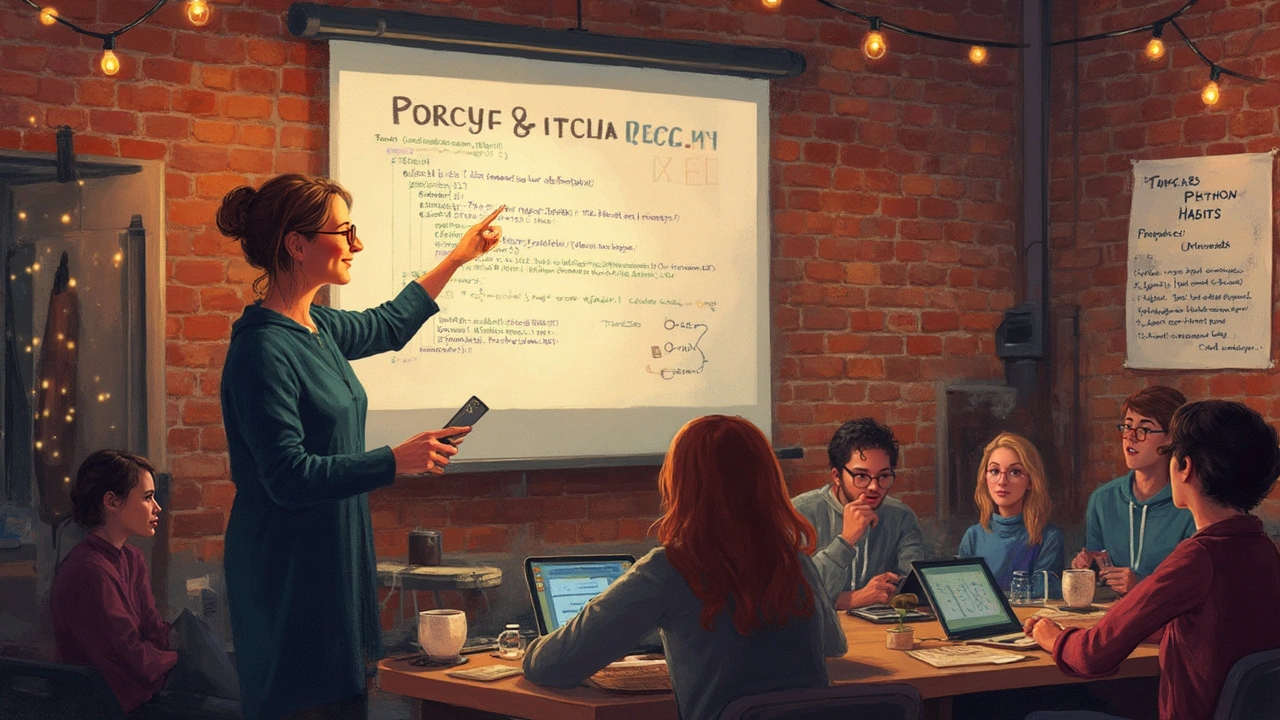You don’t need another course to write better Python. You need a small set of habits you repeat daily: write tiny scripts, read great code, lean on the standard library, profile before optimizing, and automate your checks. This guide gives you the exact steps, patterns, and tools that raise your ceiling fast, with 2025-ready features like Python 3.12/3.13 typing upgrades, pattern matching, and safer packaging.
- Use the standard library first: pathlib, dataclasses, itertools, functools, contextlib, and enum cover most day-to-day needs.
- Lock in style and feedback loops: Black, Ruff, and type checks (mypy/pyright) catch issues early; pytest keeps you honest.
- Measure, don’t guess: cProfile, timeit, scalene/line_profiler reveal real bottlenecks. Then fix the 20% that matters.
- Adopt modern Python: pattern matching (PEP 634-636), f-strings formalized (PEP 701), type parameter syntax (PEP 695), and newer dict/list optimizations.
- Ship small: weekly mini-projects beat giant plans. Fold learning back into your daily work.
Step-by-Step: Your 30‑Day Plan to Become a Better Python Developer
Here’s a realistic plan that fits around a busy job. Each week has a theme, a daily 30-45 minute routine, and a tiny deliverable. Keep the deliverables small. Momentum is the win.
-
Week 1 - Idiomatic Python and the Standard Library
- Install tools: Black (formatting), Ruff (lint + import sorting), mypy or pyright (types). Configure in pyproject.toml.
- Read PEP 8 (style) and PEP 20 (The Zen of Python). These are short and shape your taste.
- Replace os.path with pathlib. Replace manual try/finally with context managers from contextlib. Use dataclasses for simple models.
- Daily: rewrite one old function using itertools, functools, or pathlib. Keep a before/after gist for reference.
- Deliverable: a small CLI tool (e.g., folder deduper) with logging and a proper entry point (if __name__ == "__main__").
-
Week 2 - Tests and Debugging
- Learn pytest basics: parametrization, fixtures, tmp_path, monkeypatch. Add coverage run to CI.
- Use logging over prints; wire LOGLEVEL via environment variable. Add structured context to errors.
- Adopt breakpoint() and inspect for live poking. Get comfy with pdb/ipdb or your IDE’s debugger.
- Daily: write one failing test for a bug you previously fixed by hand. Make the test describe the bug in plain English.
- Deliverable: 80%+ coverage on your small CLI; sensible log lines; zero flake8/ruff errors.
-
Week 3 - Types, Architecture, and Packaging
- Read PEP 484 (type hints), then modern updates: PEP 695 (type parameters), PEP 681 (typing_extensions support for dataclass_transform).
- Add types to public functions only. Use Protocol for duck typing; TypedDict or dataclasses for structured data.
- Package with pyproject.toml. Use uv or pip-tools to pin and sync dependencies; pipx for global tools.
- Daily: add types to one module; fix issues flagged by mypy/pyright. Prefer simple, explicit types over cleverness.
- Deliverable: library-quality packaging (pyproject), type-checked public API, pre-commit hooks for format/lint/type checks.
-
Week 4 - Performance, Concurrency, and Reliability
- Profile a real script with cProfile and scalene/line_profiler. Optimize only hot paths.
- For I/O bound tasks, use asyncio or ThreadPoolExecutor. For CPU bound tasks, use ProcessPoolExecutor or NumPy.
- Cache pure functions with functools.lru_cache; stream data with generators; avoid N+1 queries and repeated disk hits.
- Daily: measure one hotspot with timeit or perf_counter, apply one change, re-measure. Keep a log of results.
- Deliverable: documented speedups (even 20-30% counts) with a short note on what worked and why.
Examples You Can Steal: Idiomatic Patterns and Snippets
These are simple changes that add up. Copy, tweak, keep them in your snippets folder.
# 1) Use pathlib for paths
from pathlib import Path
data_dir = Path.home() / "data" / "events"
for p in data_dir.glob("*.json"):
print(p.name)
# 2) Use context managers
from contextlib import suppress
with open("out.txt", "w", encoding="utf-8") as f:
f.write("hello\n")
with suppress(FileNotFoundError):
Path("missing.txt").unlink()
# 3) Dataclasses with sensible defaults
from dataclasses import dataclass, field
from datetime import datetime
@dataclass(slots=True)
class Job:
id: int
tags: list[str] = field(default_factory=list)
created_at: datetime = field(default_factory=datetime.utcnow)
# 4) Enumerate + zip beat manual indexing
names = ["max", "ava", "liam"]
scores = [91, 88, 77]
for i, (n, s) in enumerate(zip(names, scores), start=1):
print(i, n, s)
# 5) Comprehensions: fast and clear
squares = [x * x for x in range(10) if x % 2 == 0]
# 6) Walrus operator to avoid double work
lines = ["ok", "", "end"]
while (line := lines.pop(0)):
print(line)
# 7) Pattern matching (PEP 634)
match payload := {"type": "user", "id": 42}:
case {"type": "user", "id": int uid}:
print("User:", uid)
case {"type": "order", "id": int oid}:
print("Order:", oid)
case _:
print("Unknown")
# 8) Safe subprocess calls
from subprocess import run, CalledProcessError
try:
run(["git", "status"], check=True, text=True)
except CalledProcessError as e:
print("git failed:", e)
# 9) Caching pure functions
from functools import lru_cache
@lru_cache(maxsize=1024)
def fib(n: int) -> int:
return n if n < 2 else fib(n - 1) + fib(n - 2)
# 10) Types without over-complication (PEP 695)
from typing import TypeVar, Iterable
T = TypeVar("T")
def first(xs: Iterable[T]) -> T | None:
for x in xs:
return x
return None
Use these as starting points. Keep a small “kitchen sink” repo with before/after examples you can search when you forget a pattern.

Performance and Debugging: Measure, Don’t Guess
Speed without proof is a feeling. Use the tools and some steady rules of thumb.
- Start with a profile, not a hunch. Use cProfile for a bird’s-eye view, then drill down with line_profiler or scalene.
- Use timeit for micro-benchmarks. Benchmark realistic input sizes and include setup cost.
- Fix data structures first: dict/set membership beats list membership once N gets large. Generators keep memory steady.
- Push work to C code: built-ins, comprehensions, itertools, and libraries like NumPy run tight loops in C and tend to be faster.
- Prefer I/O streaming over reading everything at once. Write generators to pipe data through stages.
# Quick profile
import cProfile, pstats
with cProfile.Profile() as pr:
main() # your entrypoint
pstats.Stats(pr).strip_dirs().sort_stats("cumulative").print_stats(20)
# Micro-benchmark with timeit
from timeit import timeit
setup = "data = list(range(10000))"
stmt1 = "[x*x for x in data]"
stmt2 = "out=[]\nfor x in data:\n out.append(x*x)"
print("comp:", timeit(stmt1, setup=setup, number=200))
print("loop:", timeit(stmt2, setup=setup, number=200))
Expect comprehensions to beat append-loops for simple transforms, and dict/set lookups to be constant-time on average. But the profile is the judge.
| Technique | Typical speed-up range | When it helps | Notes (CPython 3.12/3.13) |
|---|---|---|---|
| List/dict/set comprehensions vs. manual loops | 1.5×-3× | Pure Python loops doing simple transforms | PEP 709 and other optimizations make comprehensions tighter |
| dict/set membership vs. list membership | 5×-20× for large N | Frequent membership checks | Hash lookups are O(1) average vs. O(N) scan |
| functools.lru_cache on pure functions | 2×-100× | Repeat calls with same args | Watch memory; set maxsize and .cache_clear() when needed |
| Vectorization with NumPy | 10×-100× | Numeric arrays and math-heavy loops | Moves work to C; avoid Python loops |
| ThreadPool for I/O bound tasks | 2×-10× | Network/disk waits | Python GIL isn’t a blocker for I/O; use asyncio or Threads |
| ProcessPool for CPU bound tasks | 2×-8× on 4-8 cores | Pure CPU work | Overhead matters; batch work to reduce pickling costs |
Heuristics I trust:
- 80/20 rule: 20% of code burns 80% of time. Find that 20% with a profile before touching anything else.
- One change at a time. Re-measure after each tweak or you’ll fool yourself.
- Prefer algorithms over micro-optimizations. A better data structure beats clever code.
- IO-bound? Use asyncio or threads. CPU-bound? Use processes or native extensions (NumPy, Cython).
Checklist and Cheat-Sheet: Style, Types, Tests, Tools
Run this at work and on side projects. It’s boring in a good way.
- Style & Lint: Black, Ruff (enforce PEP 8, ban footguns like mutable default args, sort imports)
- Types: mypy or pyright; use Protocol for plug-in interfaces; TypedDict or dataclasses for structured data
- Tests: pytest, pytest-cov, hypothesis (for property-based tests on tricky logic)
- Packaging: pyproject.toml; uv or pip-tools for locking; pipx for global CLIs
- Security: pip-audit or Safety to flag known CVEs in dependencies
- CI: pre-commit hooks running format/lint/types/tests on every push
# pyproject.toml (minimal, extend as needed)
[tool.black]
line-length = 100
[tool.ruff]
line-length = 100
select = ["E", "F", "I", "B", "UP", "SIM", "PL"]
ignore = ["E501"] # handled by Black
[tool.pytest.ini_options]
addopts = "-q --strict-markers --maxfail=1 --cov=. --cov-report=term-missing"
Common footguns and the safer move:
- Mutable default args: def f(x, seen=[]): … -> use field(default_factory=list) or None + new list
- String concatenation in loops -> collect and "".join(parts)
- Manual path joins -> pathlib.Path and operators
- Manual resource cleanup -> use with context managers
- Guessing performance -> profile first, then change
When types get gnarly, pull back. Add types to module boundaries and critical utilities first, then expand. The goal is clarity, not type golf.

FAQ, Next Steps, and Troubleshooting
You probably have a few “yeah, but…” questions. Short answers below, then some paths based on your role.
FAQ
Which Python version should I target in 2025?
Python 3.12 is stable and fast; 3.13 is current as of late 2024 and widely available in 2025. Target the newest your production supports. Watch release notes for optimizations and typing updates.
Black vs. Ruff vs. Flake8?
Black formats, Ruff is a fast linter that replaces many Flake8 plugins and sorts imports. Use both. Keep configs minimal.
mypy or pyright?
Both are solid. mypy is widely used in Python ecosystems; pyright (TypeScript team) is fast with great editor integration. Pick one and stick with it.
Is asyncio worth learning?
Yes, for I/O-bound tasks (HTTP calls, DB, files). It won’t speed up CPU work by itself. Use ThreadPoolExecutor for quick wins when you have blocking libraries.
What about data science?
Push loops to NumPy; use vectorized operations; minimize pandas .apply where possible; consider polars for speed; profile with memory usage in mind.
Authoritative sources to trust?
PEP 8 (style), PEP 20 (Zen), PEP 484 (typing), PEP 695 (type parameters), PEP 701 (f-strings), PEP 634-636 (pattern matching). The Python docs and PEPs are primary sources.
Next steps by persona
Backend engineer
Learn FastAPI with type hints end-to-end, use pydantic v2 for validation. Add async DB drivers or ThreadPool for blocking I/O. Bake in OpenAPI and property-based tests for handlers.
Data engineer
Adopt pathlib, gzip, and streaming CSV/JSON processing with generators. Use sqlite/parquet for staging. Profile with cProfile + memory focus; move heavy transforms to polars or Spark when needed.
Data scientist
Use notebooks for exploration, but freeze logic into tested modules. Replace loops with NumPy; use numba when pure Python is too slow. Track experiments and seed randomness for reproducibility.
DevOps/SRE
Write solid CLIs with argparse or click; add logging and retries with backoff; ensure idempotency. Package as a Docker image with a slim base; scan dependencies with pip-audit.
Troubleshooting common issues
“My linter screams at me.”
Silence style noise by adopting Black first. Then enable Ruff rules gradually. Use @pytest.mark.xfail for known failures while you refactor.
“Types are slowing me down.”
Type the boundaries: functions that cross modules or talk to the outside world. Add internal types when the code stabilizes.
“Async made everything harder.”
Start with threads for I/O. Move to asyncio only when you need structured concurrency and cancellation.
“Performance gains vanished in production.”
Benchmark with real data and environment flags. Production often has different I/O, CPU limits, and caches. Profile there too.
“Our tests are flaky.”
Remove hidden time and randomness; use freezegun or datetime injection; isolate filesystem with tmp_path; mock network calls; run tests with -n auto (pytest-xdist) for load-related flakiness.
If you want one north star sentence: learn the standard library and enforce feedback loops. That combo compounds fast. Use these Python tricks as the daily scaffolding, not a one-off binge, and your codebase-and your sanity-will thank you.

